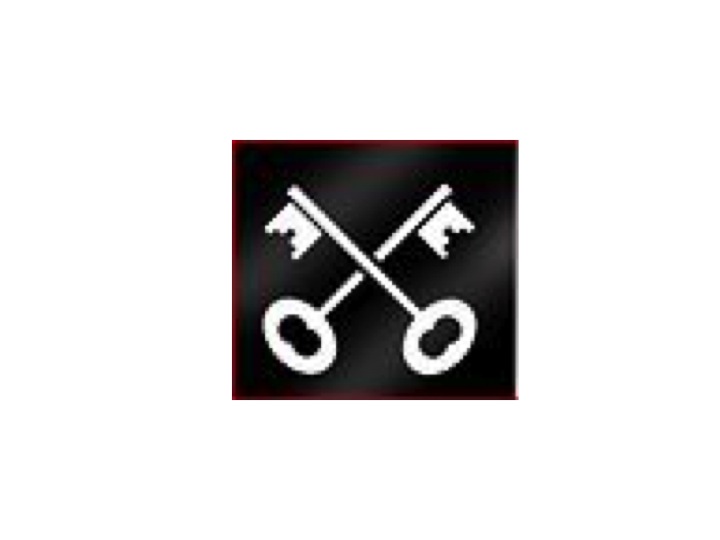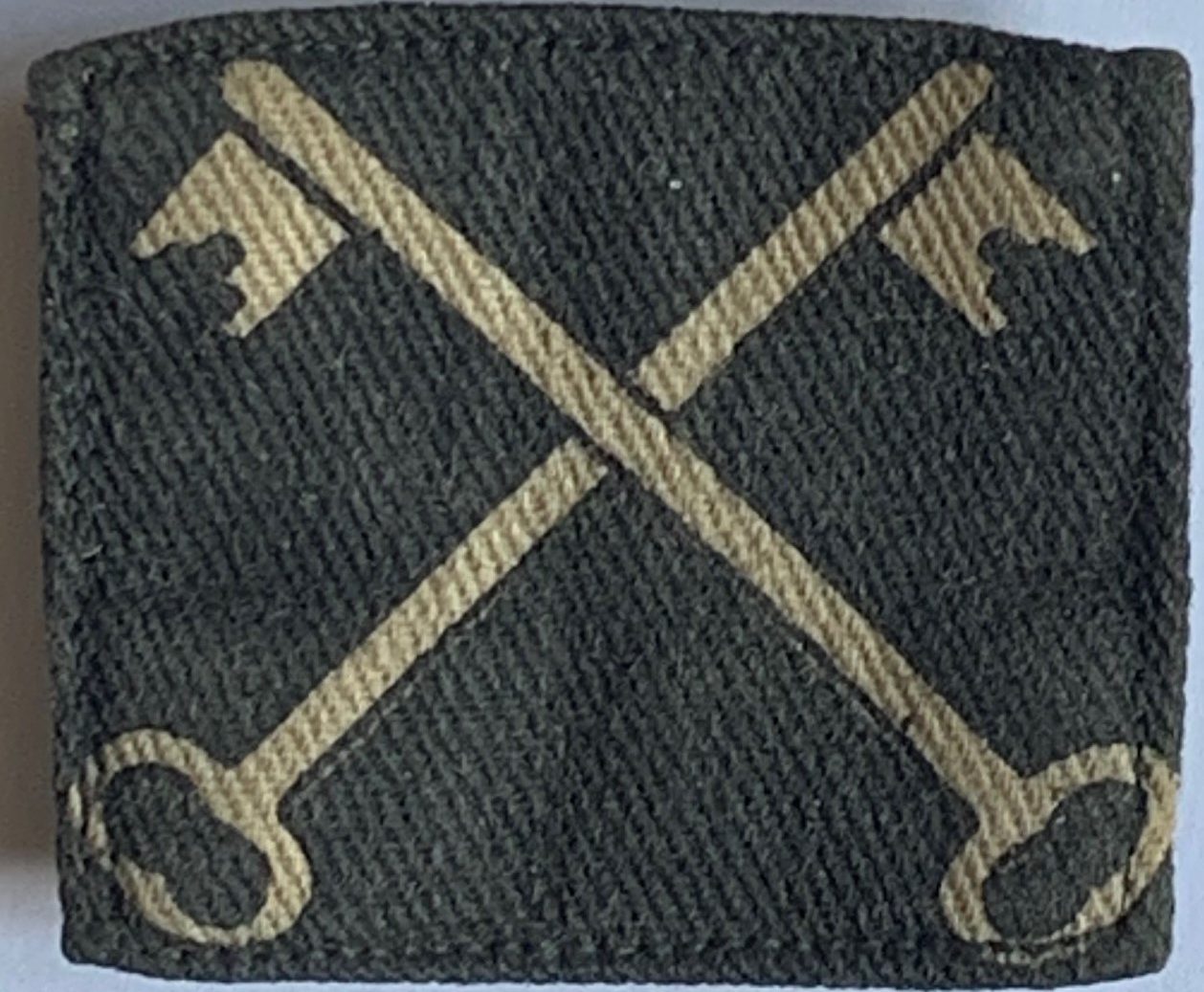Japanese Invasion Money
After conquering countries, the Japanese military confiscated their currency and replaced it with invasion money issued by the Southern Development Bank, which was established in 1942 to provide financial services in occupied regions. Such money was first issued in the Philippines and subsequently in regions including the Dutch East Indies, Malaya, Singapore and Burma. The bank notes below are rupees printed by the Japanese for use in Burma & are on display at the Kohima Museum.
When Japan surrendered, Southern Development Bank notes lost all their value. Citizens received no compensation when this money became worthless. Japanese troops were ordered to destroy it & many tons were burned or dumped. The picture below is of a photographer surrounded by discarded invasion money in a street in Rangoon.
Kohima Epitaph
Below is a bronze plaque that commemorates the British 2nd Infantry Division in WW2. It used to be on a pillar in the chancel of the Royal Garrison Church in Aldershot. Major General Grover noticed that it mis-quotes the Kohima epitaph, with “… for their tomorrow …” instead of “… for your tomorrow …” . He insisted on its replacement with a correct version. The erroneous original can now be seen at the Kohima Museum.
This artefact also features some unusual hyphens in “to-morrow” & “to-day”.

Monsoon Cape
The monsoon brought misery to the troops in south east Asia. The heat & humidity required a lightweight garment that would dry out quickly & could be rolled & stored easily. British troops were issued with voluminous monsoon capes, the shape throwing water clear of the wearer & covering equipment worn underneath easily. They were made in India from cotton. They brought little relief, one recipient complaining:
“We have been issued with an absolutely useless piece of equipment namely, Wait for it! THE MONSOON CAPE useless because when wearing it, you could do nothing but ride a bicycle, which we did not have. You actually got wetter and stickier from your own sweat in a downpour than if you let the cooling monsoon rain pour off your shoulders.”
The BBC archive “WW2 People’s War” has the following by Frederick Weedman:
“It was mid-May 1944 when the monsoon rain started. It started as a thin continuous quiet pouring rain. We unpacked and put on our only protection against it …. our voluminous monsoon capes.
But even these did not prevent this rain from penetrating inside our clothes, and with the sweat from our bodies, it ran into our boots! It soaked our webbing so that it was as heavy as lead, and we felt that we had been condemned never to be dry.
I have vivid recollections of ‘C’ Company 7th Worcestershire Regiment splashing and slipping in the deep mud, our weapons on our shoulders, our mud fouled haversacks and groundsheets flapping behind us, marching, marching, bent with fatigue. Most of us by now had substituted the heavy steel helmets for the more comfortable but by now soaking and drooping, felt Burma Hats that drooped over our eyes.
Every few yards, someone sprawled on his face in the mud, arose and after shovelling the mud off himself, toiled onwards. Our main concern was to keep the mud off our weapons. They were our passport to survival. Each time our legs took the weight of our bodies, the packs on our backs, and our weapons, our knees would complain from the pain it gave them. And the penetrating rain made us shiver and wonder if we had malaria. There seemed no end to it. All we could do was to keep staggering upwards.
It was in these conditions that, after a time in action, a fatalistic attitude takes possession of the mind, an indifference possessed us to the dangers of attack. And so we trudged on, wearily climbing the steep mountains and the winding tracks that were like great rivers of mud.”

A Japanese Hand Grenade
A Japanese Type 91 hand grenade is on display in the Kohima Museum. It is made from cast iron and is serrated to ensure maximum fragmentation. When filled with TNT, it weighed 1lb 5oz.
These grenades were fused to explode after four or five seconds, but the fuses were somewhat unreliable. If tempted to use captured grenades, Allied troops were advised to throw them as soon as they were activated.
To arm their grenades, Japanese soldiers had first to remove the pin & then depress the top by pushing it against something solid, such as a tree, helmet or boot; this would ignite it, ready to throw. British soldiers learned to take cover if they heard the metallic sound of a grenade being struck against a helmet. Once activated in this way, black smoke was emitted, as well as a speck of blue light that was visible at night.
Private Nobuyuki Hata of 58th Infantry Regiment described how men would remove the pins from their grenades in preparation for action:
“When we mounted close-range attacks, we’d take three, four or five hand grenades & pull the safety pin out. And we’d put them in our pockets. When we charged the enemy, we’d have grenades in one hand. You usually pull out the safety pin with your mouth, but we didn’t have time for that. The pin would already be out, so we’d bounce the grenades against the soles of our shoes. We went out knowing full well we could self-detonate. When you’re charging the enemy, you’re driven into this state of madness. Of course it’s terrifying, but you can’t just hang back & not do anything. When you charge the enemy, you just become this crazed being.” (3)

Major General Grover’s Diary
The Kohima Museum displays the diary of Major General Grover, Commander of 2nd British Infantry Division during the battle of Kohima. The entry for 22 June 1944 begins “Opened Imphal Rd”.


Japanese Battalion Gun
The Kohima Museum displays a Japanese Type 92 Battalion Gun (70 mm Howitzer). Two of these guns were issued to each infantry battalion & so they saw very widespread service.
Their relatively light weight (476 lbs) made these versatile infantry support weapons mobile & allowed them to be moved over rough terrain & brought to bear quite easily.
They were normally towed by horses or mules, but could be dragged or carried by teams of men. The shield could be removed to reduce weight. Holes & brackets in the carriage allowed poles to be inserted to facilitate manual carriage. They could also be dragged by men using harnesses. Although a crew of four or five was used to operate the gun (commander, gunner, loader & two ammunition bearers), a full team of ten provided the manpower needed to move the gun & bring ammunition.
The Type 92 Battalion Gun had a 70 mm calibre & fired a high explosive shell of 8.7 lb, with a range of 3,000 yds (2,785 m). It could also fire armour piercing & smoke shells. It had a rate of fire of 10 rounds per minute. Wheels were used to adjust the elevation (-10° to +50°) & traverse (45°).

The Tank on the Tennis Court
On May 13th 1944, a 30 ton Grant tank dropped 10 yds from the terrace above onto the tennis court on Kohima Ridge & finally broke the resistance of the Japanese there, with the help of infantry from the 2nd Dorsets.
The picture above shows a painting by Terence Cuneo of how he imagined the scene. The painting is displayed in the Kohima Museum. Terence Cuneo (1907 – 1996) was a prolific English painter noted for his scenes of railways, horses and military actions. He was the official artist for the Coronation of Queen Elizabeth II in 1953.
The tank on the tennis court was captured on newsreel film. A still is shown below.

Flag of Queen’s Own Royal West Kents at Kohima
The Kohima Museum is proud to display the flag of 4th Battalion Queen’s Own Royal West Kents, that flew on Garrison Hill during the epic siege of Kohima, April 4-18, 1944. It shows the White Horse and Invicta motto of Kent, translated as “Unconquerable”. Garrison Hill was the only part of Kohima that the invading Japanese army failed to capture.

Energy Tablets
To meet the Japanese invasion of India in March 1944, the allies flew 5th Indian Division into Imphal & Dimapur between March 17 & 29. Transferring each of its three brigades needed 260 Dakota sorties. For most of the men, it was the first time they ever flew. As well as troops, guns, vehicles & mules were transported. 7th Indian Division was then transferred in the same way.
Return flights carried 43,000 non-combatants & 13,000 casualties from the war zone. After the road from Kohima was cut, 540 tons of supplies were flown into Imphal each day by Operation Stamina.
With two sorties per day, flight crews were exhausted. To keep them going, they were issued with “Energy Tablets” that contained drugs that would not only “Ward off sleep”, but also “Stave off depression”.
The examples above are on display at the Kohima museum. Their instructions state that the tablets should not be given to wounded, excitable or hysterical men or those whose minds are wandering, as they would make them worse.

Japanese Propaganda
The Kohima Museum has interesting Japanese propaganda intended to encourage Indians to turn against the British.
The drawing below depicts Japanese troops in the jungle greeting men of the Indian National Army (INA).
The INA was largely recruited from Indian POWs captured after the fall of Malaya and Singapore. An INA division of 16,000 accompanied the invasion of India in 1944. They expected to persuade Indians fighting alongside the British to change sides in large numbers, but such defections were rare. Despite the propaganda, Japanese troops often showed little respect for the INA, which was largely ineffective as a fighting force. Many of the INA became disillusioned and desertion was common.

Type 38 Japanese Carbine
The Kohima Museum has a Japanese Type 38 carbine, that was taken in 1945 at an ambush during a night patrol across the Mu river, between the Chindwin and Mandalay. Type 38 refers to the fact that it was introduced in the 38th year of Meiji (1905). It was donated by Dr JS MacRobert.
The Type 38 carbine was a shorter (33 inch) version of the Type 38 rifle (50 inches), one of the most widely used Japanese infantry weapons (pictured together below, with bayonet and scabbard).
Based on a bolt-action mechanism patented by Mauser, they were robust and reliable. An internal magazine was loaded with a clip carrying five 6.5mm cartridges. The carbine was intended for cavalry, engineers & artillery, but was adopted by many infantry units as its shorter length made it easier to handle in jungle conditions.

A Gift from Japanese Survivors of Kohima
The Battle of Kohima was fought by the British 2nd Infantry Division and Indian troops under Command against the 31st Division of The Imperial Japanese Army.
In 1984, surviving veterans of 31st Division laid a wreath at the Kohima Memorial at York Minster, pictured above. They visited HQ of the 2nd Division (then in York) & presented the model of traditional samurai armour shown below.
The suit of armour was on display at the Divisional HQ in Craigie Hall, Edinburgh, until the Division was withdrawn from the Order of Battle of the British Army in 2012. It was then signed over to the Trustees of the Kohima Museum, where it is now displayed and cared for.
The word “Samurai” means “ones who serve”. They were hereditary military nobility who fought for a lord or daimyo from the 12th Century until their abolition in the 1870s. Their armour was largely composed of small steel plates covered in lacquer and linked by strips of leather. The mask is intended to terrify their enemies.























